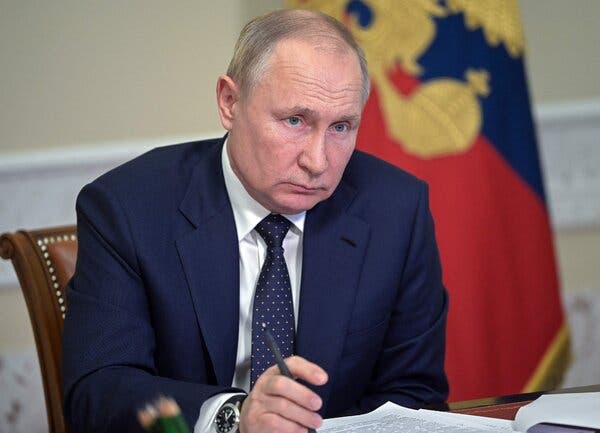
Russia Smashing Ukraine Into Pax Russica (Part One)
Publication: Eurasia Daily Monitor Volume: 19 Issue: 37
By:

A fourth round of Russian-Ukrainian “peace” negotiations started on March 14 and is continuing as of today (March 17), the 21st day of Russia’s invasion into Ukraine’s interior. Russia’s deliberate attacks on Ukrainian population centers and civilian infrastructure, its superior firepower, and its seizure of sizeable chunks of Ukrainian territory has compelled President Volodymyr Zelenskyy to initiate these negotiations. Kyiv’s uppermost goal was a ceasefire, but Russia refuses it and is likely to continue the hostilities—prioritizing civilian targets—unless and until Kyiv offers major political concessions.
Three preliminary negotiating rounds were held on February 28, March 3, and March 7 (Ukrinform, TASS, March 1, 4, 8), all on the territory of Belarus (the Ukrainian side had to accept this unwanted location). The full-fledged negotiations began on March 14 with the fourth round, henceforth by video-conference. From this point onward, the process is structured in plenary sessions of the full delegations and breakout sessions by working groups on specific issues.
This process lacks transparency. The Russian side maintains near-secrecy on it. The Ukrainian side’s reports are scant and seek to obscure the extent to which Russia has shaped the agenda of these negotiations. Leading the process on the Ukrainian side is the Presidential Office under Andriy Yermak, and the messaging (unenlightening though it is) goes out through Yermak’s own aides Mykhailo Podoliak and Oleksiy Arestovich. A lead role by the Ministry of Foreign Affairs and the National Security Council would have raised the Ukrainian delegation’s professional level, indeed fitness, to negotiate with the Russians. Defense Minister Oleksiy Reznikov was the delegation’s most senior official during the initial rounds, but his participation is not being reported at this moment.
The Kremlin had announced its war aims through six major statements, between February 21 and 25. These included two addresses by President Vladimir Putin to his country, two enlarged sessions of Russia’s Security Council, a Putin news conference and a Putin interview (see EDM, February 22–25). The Kremlin listed its war aims as:
– Ukraine to officially recognize the Crimean peninsula’s incorporation into Russia; and to officially recognize the Donetsk and Luhansk “people’s republics” as independent states, within the borders of Ukraine’s former Donetsk and Luhansk provinces (Ukraine had controlled two thirds of those provinces’ land area until February 24).
– Ukraine to renounce the goal of joining the North Atlantic Treaty Organization (NATO) and remove that commitment from its constitution.
– “Demilitarization” of Ukraine, defined as excluding a Western military presence on Ukraine’s territory and shrinking Ukraine’s own armed forces. Targeting Ukraine’s military infrastructure is one of Russia’s declared military objectives in this war.
– “De-Nazification” of Ukraine, potentially targeting any patriotic Ukrainian groups in territories that Russia would directly seize or indirectly control through its proxies.
– Opportunities for all the “peoples” in certain parts of Ukraine to exercise the right to decide how they wish to live in the future—allusion to breaking up Ukraine into autonomous units along ethnic or linguistic lines.
– De-legitimizing Ukraine’s incumbent leadership. Depicting President Zelenskyy, the parliament and government as the direct result of the 2014 EuroMaidan “neo-Nazi, US-supported coup d’état,” the Kremlin pretends to ignore the fact that the incumbent leadership came to power through the 2019 elections. Nevertheless, the Kremlin has now chosen to negotiate with this leadership (see below).
Russian Foreign Minister Sergei Lavrov has added two further political objectives of the war in the ensuing negotiations. These two are “issues of paramount interest to us” (MID.ru, March 16):
– Legal guarantees for the use of Russian language in the public sphere in Ukraine, return of Russia’s mass media to Ukraine’s information space, guaranteed rights to “all those who consider themselves national minorities […] who have been trampled under in every way,” as well as “guarantees of physical security to people in eastern Ukraine and in other parts of Ukraine.”
– Ukraine to adopt the status of a neutral country, under international security guarantees. These are yet to be worked out and must be “mutually acceptable to Ukraine and all countries involved, including Russia.” It is not enough for Ukraine to stay out of NATO. The United States, the United Kingdom, and Canada have armed and trained Ukrainian forces bilaterally, outside the Alliance. Russia is prepared to allow Ukraine to possess military forces that do not threaten Russia.
Russia has introduced a draft “peace” plan for consideration in the fourth round of the negotiations. This draft apparently includes all or most of the goals already announced, adding a ban on foreign bases or infrastructure on Ukraine’s territory and limitations on Ukraine’s own forces (Ukrinform, PBS NewsHour, March 16).
In this light, Russia’s March 13 long-range missile attack on Ukraine’s Yavoriv military training range, killing 35 and injuring at least 130 (Interfax-Ukraine, March 14), looks like a shot across the bow, not of NATO but of those Western allies that have been training Ukrainian troops at Yavoriv on a bilateral basis (bypassing NATO).
According to Lavrov, the Russian and Ukrainian delegations to these negotiations are to work out and finalize a comprehensive agreement that would be ready for Presidents Putin and Zelenskyy to crown with their signatures.



